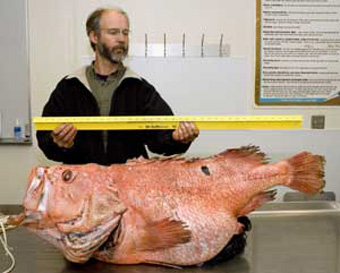 April 10, 2007
The huge rockfish was one of
about ten rockfish accidentally scooped up by fishermen in a
net that brought in around 75 tons of pollock, Myers explained. Myers explained that the crew alerted him about the huge creature. He told them to freeze the big rockfish whole. The shortraker rockfish Myers had frozen is 112 centimeters (about 44 inches) long and weights almost 27 kilos (almost 60 pounds). While that's a truly huge shortraker rockfish, it's not a record. The book 'Fishes of Alaska' (Mecklenberg) cites a maximum known size of 120 centimeters (about 47 inches), and another at 116 centimeters (about 46 inches) reported caught off eastern Kamchatka in the early 1990's. "We're grateful to Mike Myers and Trident Seafoods for giving this huge specimen for research," said Alaska Fisheries Science Center Director Doug DeMaster. "We are gathering scientific information from her." But the NOAA scientists aren't the first non-fishermen to get a look at the frozen rockfish. Myers first took the fish to his sons' grade school, Immaculate Conception Our Lady of Perpetual Help School in Everett, Washington. Myers said that while the students were fascinated (and one younger student was frightened) by the rockfish, the students "didn't go quite as crazy over it as the researchers" at the Alaska Fisheries Science Center in Seattle. Researchers have carefully measured, photographed and documented the specimen. They have removed an otolith (ear bone) from the giant rockfish and from the otolith have estimated the fish's age between 90 and 115 years. Otoliths contain growth rings--similar to the growth rings on the trunks of trees--which allow scientists a method for estimating age. Researchers are also taking tissue samples to study the fecundity of the rockfish, and are analyzing the stomach contents.
Source of News & Photograph:
Publish A Letter on SitNews Read Letters/Opinions
|
||
